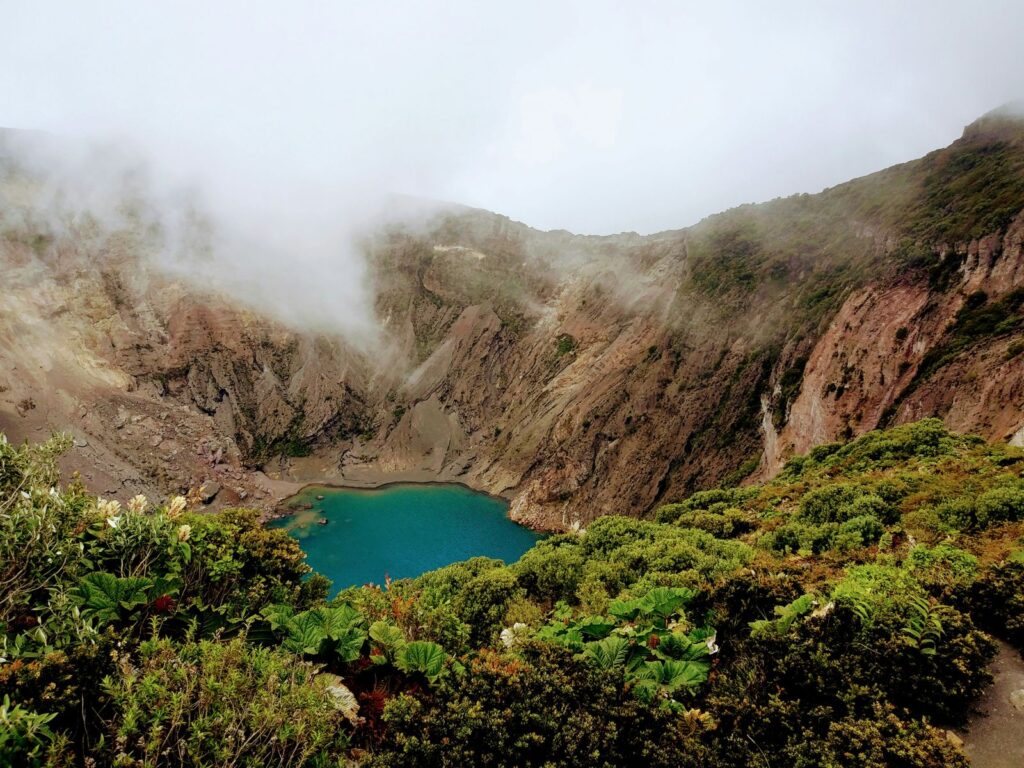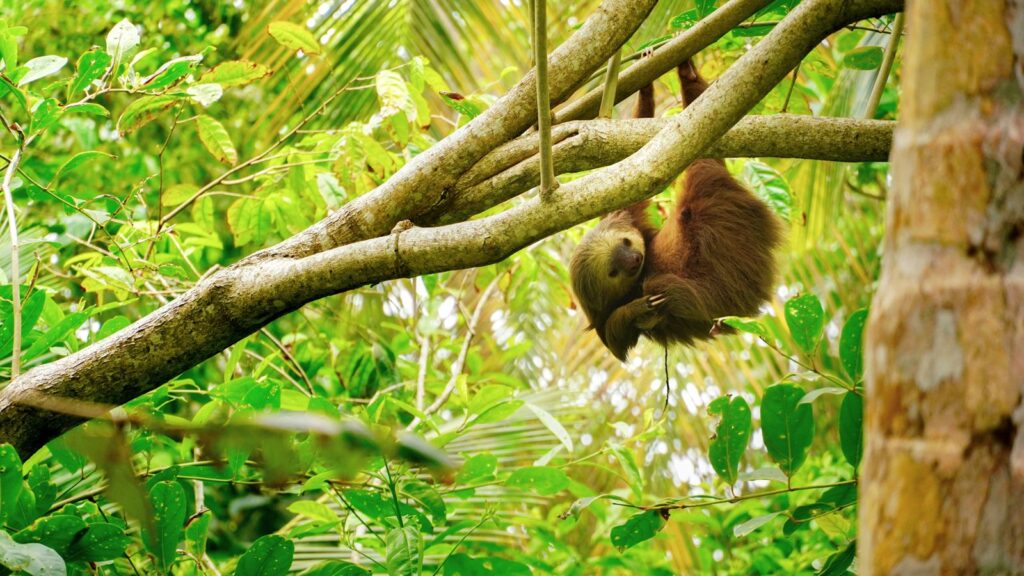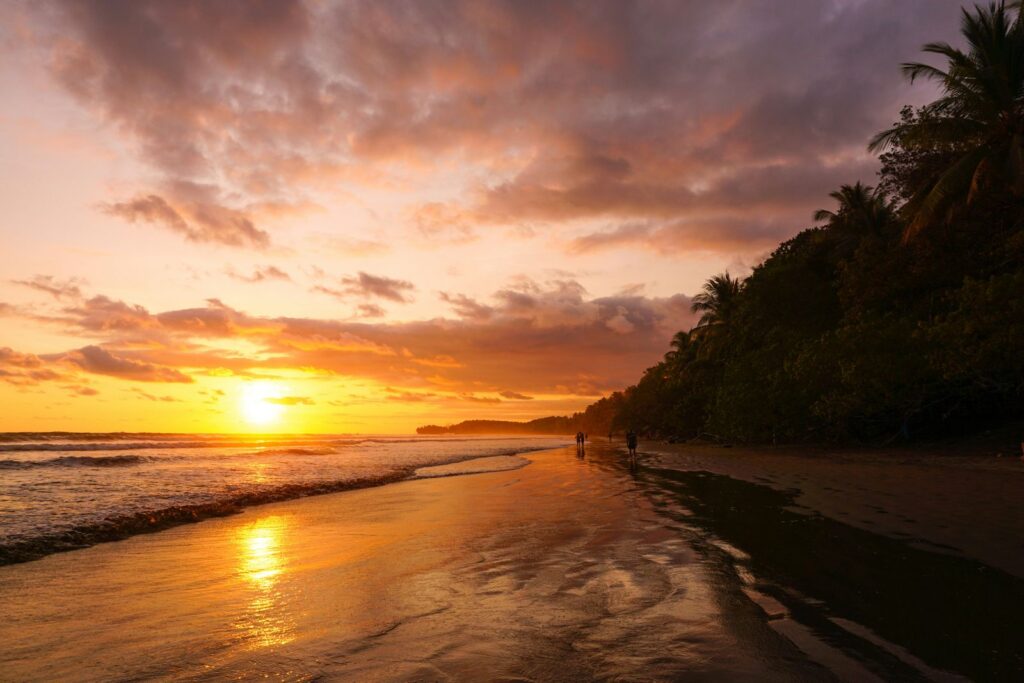Costa Rica is one of the countries we have launched this year as a destination where you can live your volunteer experience and an amazing place to enjoy a meaningful trip while taking in everything it has to offer.
In other blog posts you can find information on typical food or some of the animals you might encounter, since it’s home to many species.
But this destination is wonderful to explore in its full splendor: dreamlike landscapes, paradise beaches, tropical rainforests, volcanoes, and so much to do.
Today we’ll talk about some must-sees you can’t miss if you’ve chosen it as your international volunteer experience destination.

– ARENAL VOLCANO
It’s one of the most popular places to visit in Costa Rica and is located within Arenal Volcano National Park, near the town of La Fortuna, in the province of Alajuela (about 3-4 hours from San José).
It stands about 1,670 meters above sea level and has been in a “resting phase” since 2010, although it’s still an active volcano. The most ‘violent’ eruption happened in 1968 after centuries of inactivity, and until 2010 it was spewing lava, gases, rocks, and ash almost every day. Its shape is an almost perfect cone (stratovolcano), making it one of the most photogenic in the world, and it is approximately 7,000 years old.
It is surrounded by tropical forests and rainforests and is home to great biodiversity (monkeys, sloths, toucans, frogs, orchids, and much more). The park covers about 12,000 hectares and offers various activities: hikes along easy, well-marked trails with hanging bridges and ziplines, climbing the volcano (although the summit is often cloud-covered—you can see petrified lava from past eruptions), visiting hot springs (a result of volcanic activity) with paid options for every budget or free ones like the thermal river near the bridge on the road. You can also visit La Fortuna Waterfall, a stunning 70-meter cascade with about 500 steps down and a swimming area at the base if the current isn’t too strong, visit Lake Arenal where you can go kayaking, paddle boarding, fishing or watch the sunset (this artificial lake is the largest in the country and was created to generate hydroelectric power), and finally, take night tours to see wildlife after dark.
It’s essential to bring a raincoat and a change of clothes since the weather changes quickly. The best time to visit is from January to April (dry season), but during green season it’s less crowded.
There are many hotels in the area with volcano views, so the scenery in the morning or at sunset is spectacular.
– MANUEL ANTONIO NATIONAL PARK
An ideal place to combine tropical jungle and dream beaches, located in the province of Puntarenas, on the Pacific coast, near the town of Quepos about 3 hours from San José.
The park stretches over about 16 square kilometers, making it the smallest land park in Costa Rica but with incredible biodiversity, mixing rainforest, mangroves, beaches, and coral reefs.
If you’re a nature lover, this stop should be on your itinerary as it’s very popular for spotting various animals such as white-faced monkeys (capuchins), two- and three-toed sloths, iguanas, raccoons, toucans, coatis, red frogs, and more than 180 bird species. (It’s important not to feed any animals.)
On the other hand, there are several beaches to relax on, including: Manuel Antonio Beach (the most famous, calm water and perfect for swimming), Espadilla Sur Beach (one of the quietest and least crowded), Gemelas Beach (two small hidden bays), or Escondido Beach (accessible only with an authorized guide).
You can also explore its trails with different levels: the Main Trail that connects the entrance to Manuel Antonio Beach, the Punta Catedral Trail with incredible panoramic views, or the Mirador & Playa Gemelas Trail, a bit more challenging but stunning.
In the area, you’ll also find various hotels and hostels for all types of budgets, many with ocean or forest views.
It’s important to bring mosquito repellent, sunscreen, a swimsuit, and if you have them… BINOCULARS!
– TAMARINDO
A beach town with a laid-back nightlife, lots of surfing, and as they say in Costa Rica, full of pura vida. An ideal destination to combine relaxation with activities, and nature with social life.
Located on the North Pacific coast, in the province of Guanacaste and part of the Las Baulas Marine National Park. About 4-5 hours from San José by car.
This destination is special because of its large golden sand beach with amazing sunsets, its constant waves make it an ideal spot for surfing, the vibe and the area full of cafés, bars, shops and restaurants, and its blend of tourism with nature connection.
Being a surf spot doesn’t mean you have to be an expert—it’s actually a perfect place for beginners with many surf schools in the area, and there are also zones with intermediate and advanced waves for the more experienced.
We also recommend sailing at sunset on a sailboat or catamaran and enjoying the wonderful views, or snorkeling and diving during the day (even though it’s not the best area for that, you can take short tours to Catalina Islands where you can see manta rays, sharks, and lots of marine life).
Visiting the National Park is also amazing, especially from November to April, as it protects the nesting of the leatherback turtle, and you can take night tours with an authorized guide to see them.
You can also kayak through the mangroves and paddle along the Matapalo River estuary to see crocodiles, birds, monkeys, and more.
You can stay in the area and enjoy a wide variety of hotels as well as restaurants with all types of food. Although it’s a very touristy area, it’s a safe one.

– TORTUGUERO
This destination is a gem in Costa Rica, as it feels like entering a mini Amazon full of canals, tropical jungle, and wildlife everywhere. A natural and authentic experience.
It’s located on the northern Caribbean coast, in the province of Limón and is only accessible by boat or small plane, making it a very special place.
This natural sanctuary is surrounded by navigable canals, dense jungle, and virgin beaches and is home to different species of sea turtles, especially green turtles that come to nest between July and October. It’s an ideal place for ecotourism, animal observation, and kayak tours.
Aside from turtles, you can find howler monkeys, white-faced monkeys and spider monkeys, as well as caimans and crocodiles, sloths, colorful frogs, toucans, iguanas, and more than 300 bird species (a paradise for bird lovers).
As mentioned, one activity you can’t miss is exploring its canals, especially at sunrise or sunset with a naturalist guide who’ll show you all kinds of animals, even those you thought you’d never spot.
You can also go with a specialized guide to the turtle nesting area—this is a once-in-a-lifetime experience and truly unforgettable.
You can also hike through Tortuguero National Park on its short trails or walk along the beach when it’s not nesting season.
And of course, visit the town of Tortuguero, which is small, peaceful, and car-free. It’s a great way to learn about Caribbean culture, try local food, and visit the turtle conservation center.
There are many hotels in the heart of nature, some of which are only accessible by boat.
It’s important to bring light, waterproof clothing and strong repellent, as it’s an area with lots of mosquitoes. Although the best time for turtles is between July and October, there’s amazing wildlife year-round. It’s important to know that swimming on the beach is prohibited due to dangerous currents and strong surf.
Did you know that sea turtles return to the same beach where they were born to nest decades later?
– CORCOVADO NATIONAL PARK
This National Park is considered one of the most biodiverse places on the planet, a wild gem of Costa Rica, located on the Osa Peninsula, in the southwest of the country, in the province of Puntarenas. It’s an ideal place for ecotourism and adventure, being wild and remote.
According to National Geographic, it’s considered the most biodiverse park on the planet with primary forest, mangroves, virgin beaches, and estuaries. It protects 5% of the world’s biodiversity.
You can see all four types of monkeys typical of Costa Rica (howler, white-faced, spider, and squirrel), peccaries, tapirs, sloths, anteaters, jaguars, scarlet macaws, toucans, frogs, crocodiles, dolphins, and even humpback whales in season.
There are different stations to explore it: Sirena Station, the most popular and the heart of the park, accessible by foot, boat, or small plane; San Pedrillo Station, accessible from Drake Bay, with short hikes, waterfalls and lots of wildlife; and La Leona to Sirena Station, an incredible 17-kilometer route always done with a guide and requiring physical effort.
Inside the park you can only sleep at Sirena Station, which has rooms or camping areas that must be booked in advance, and outside the park there are more options.
You can only enter with an authorized guide and a prior reservation, and it’s essential to bring water, repellent, sunscreen, light clothing, binoculars, good shoes, and a camera.
It’s one of the last refuges of the jaguar in Central America. And although it’s almost impossible to see, it lives there.

These are just some of the places you can’t miss if you choose Costa Rica for your volunteer experience, but there are many more that will surprise you and leave you speechless.
So we’ll leave that for part two.
ARE WE GOING TO COSTA RICA?



